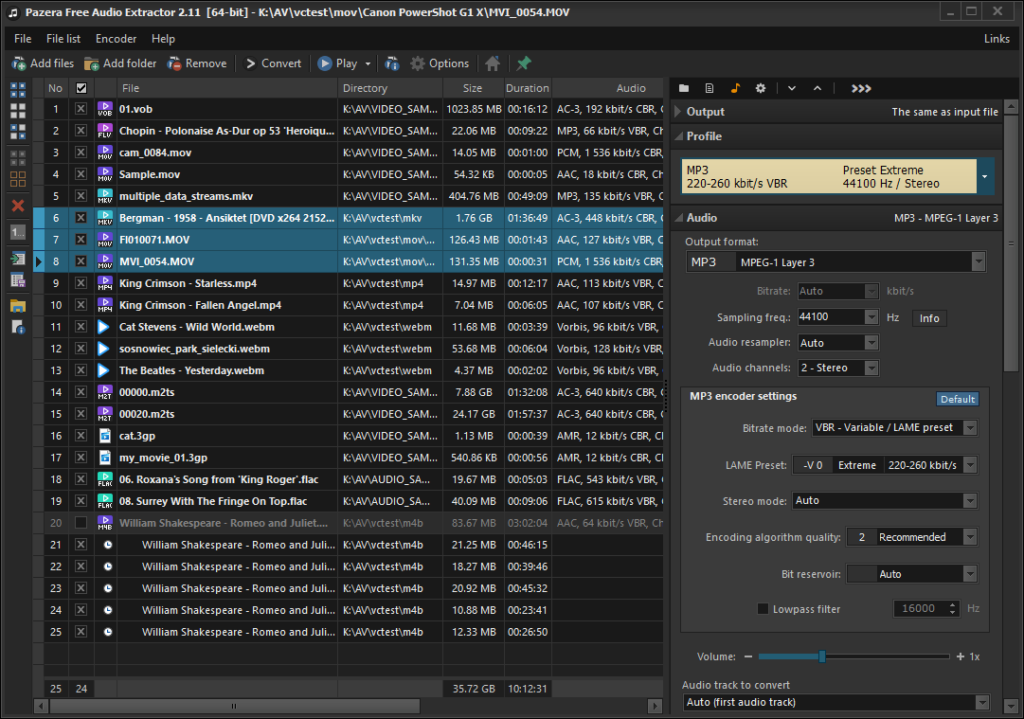A short article describing how to use the basic functions of the Pazera Free Audio Extractor program. This program is completely free and you can download it here.
Converting files / Extracting audio tracks
To convert audio files or extract audio tracks from video files, you must first add them to the list. To do this, click the button on the toolbar. Will be displayed a standard dialog box for file selection, in which you have to select one or more audio or video files, and click button. You can also add files to the list using the drag and drop technique. When you do this, the program will add your selected files to the processing list. To run the conversion/extraction, on the list must be at least one file, moreover, it must be checked in the column with check marks.
If you ran the program for the first time and have not changed any conversion parameters, will be used default settings.
At default settings, the application converts files to MP3 – the most popular audio format – and automatically selects all the encoding parameters so as to preserve the original audio quality.
You can manually set the encoding parameters on the Audio and Additional settings panels, or just select one of the predefined profiles from the Profile list.
If you want to extract the original audio track from the video file without loss of sound quality, select Try extract original audio stream on the Output format list.
The program can extract the audio tracks encoded in the following formats: MP3, AAC, M4A, WMA, OGG (Vorbis), FLAC, DTS, THD, AC3, PCM (WAV), MP2 (MPEG-2 audio), MPA (MPEG-1 audio), AMR.
The most important audio conversion parameter is audio bitrate. Generally, the higher bitrate, the better sound quality in the output file. But on the other hand, the higher bitrate, the larger output file. The whole trick is to select those bitrate value to get good sound quality at a relatively small size of the resulting file. So it is best to set the audio bitrate in Auto position, then the program will select the appropriate value automatically. However, if you want to manually set conversion parameters, you can find a lot of useful information in the File properties window (select desired file on the list and click the button on the toolbar).
If you want to reset all conversion settings to default values, select menu Encoder -> Default encoder settings.
When you set all conversion/extraction parameters, click the button on the toolbar. A new window appears, where you can track the conversion process.
Metadata (ID3v2, FLAC, WMA, MP4 (AAC), APE, Vorbis Comments and other tags) are automatically copied from the source files to the output files, if the selected output format supports storing metadata.
Managing file list
You can activate/deactivate any files in the list by checking/unchecking desired files in the 2-nd column (with the checkboxes). Only the checked files will be processed during conversion.
If you want to remove from the list some files, check them in the 2-nd column and click button on the toolbar. All checked files will be removed from the list (but not from disk!). If you want to remove all files from the list, from the menu select command.
You can change the location of files on the list using the drag and drop technique. Similarly, you can move the list columns.
If you want to show or hide some column, right-click on the file list header, and in the context menu, select or deselect the desired column.
You can sort (ascending or descending) the displayed information by clicking the appropriate column header.
Loading & saving settings
When you close the program, all conversion settings are saved to the file __Last.ini in the profiles directory. The next time you run application, conversion settings are loaded from this file.
The rest of the application settings (main window size and location, columns order and visibility, and others) are stored in the file AudioExtractor.ini in the program main directory. Of course, these settings are also loaded at the next startup.
Portability
The program does not use system registry and all settings are stored in the above-mentioned files. If you want, you can copy all files (including whole directory structure) to the USB drive, and run the program from that drive on other computers.
You can also download the program in the form of a ZIP archive and extract it to an external drive.


